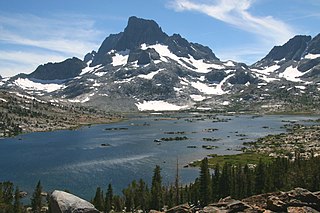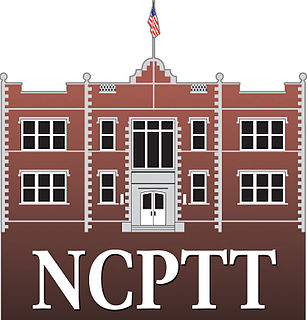Related Research Articles
The National Register of Historic Places (NRHP) is the United States federal government's official list of districts, sites, buildings, structures and objects deemed worthy of preservation for their historical significance. A property listed in the National Register, or located within a National Register Historic District, may qualify for tax incentives derived from the total value of expenses incurred in preserving the property.

Nature conservation is the moral philosophy and conservation movement focused on protecting species from extinction, maintaining and restoring habitats, enhancing ecosystem services, and protecting biological diversity. A range of values underlie conservation, which can be guided by biocentrism, anthropocentrism, ecocentrism, and sentientism. There has recently been a movement towards evidence-based conservation which calls for greater use of scientific evidence to improve the effectiveness of conservation efforts.

The National Park Service (NPS) is an agency of the federal government of the United States that manages all national parks, many national monuments, and other conservation and historical properties with various title designations. The United States Congress created the agency on August 25, 1916 through the National Park Service Organic Act.

Historic preservation (US), heritage preservation or heritage conservation (UK), is an endeavor that seeks to preserve, conserve and protect buildings, objects, landscapes or other artifacts of historical significance. It is a philosophical concept that became popular in the twentieth century, which maintains that cities as products of centuries’ development should be obligated to protect their patrimonial legacy. The term refers specifically to the preservation of the built environment, and not to preservation of, for example, primeval forests or wilderness.

There are 40 protected areas in the United States designated as national recreation areas (NRA). They are established by an act of the United States Congress to preserve enhanced recreational opportunities in places with significant natural and scenic resources. National recreation areas emphasize a variety of activities for visitors, including hiking, camping, boating, fishing, swimming, biking, horseback riding, and wildlife viewing, in areas that include multiple-use management including both conservation and limited utilization of natural resources. They have diverse features and contexts, being established around reservoirs, in urban areas, and within forests. Due to their size, diversity of activities, and proximity to population centers, NRAs are among the most visited units of the National Park System, with six among the thirty most visited sites.

The National Historic Preservation Act is legislation intended to preserve historic and archaeological sites in the United States of America. The act created the National Register of Historic Places, the list of National Historic Landmarks, and the State Historic Preservation Offices.

The Boston African American National Historic Site, in the heart of Boston, Massachusetts's Beacon Hill neighborhood, interprets 15 pre-Civil War structures relating to the history of Boston's 19th-century African-American community. These include the 1806 African Meeting House, the oldest standing black church in the United States.

The National Wilderness Preservation System (NWPS) of the United States protects federally managed wilderness areas designated for preservation in their natural condition. Activity on formally designated wilderness areas is coordinated by the National Wilderness Preservation System. Wilderness areas are managed by four federal land management agencies: the National Park Service, the U.S. Forest Service, the U.S. Fish and Wildlife Service, and the Bureau of Land Management. The term "wilderness" is defined as "an area where the earth and community of life are untrammeled by man, where man himself is a visitor who does not remain" and "an area of undeveloped Federal land retaining its primeval character and influence, without permanent improvements or human habitation, which is protected and managed so as to preserve its natural conditions." As of 2016, there are 803 designated wilderness areas, totaling 111,368,221 acres (45,069,120 ha), or about 4.5% of the area of the United States.

This is a list of properties and historic districts in Oregon that are listed on the National Register of Historic Places. There are listings in all of Oregon's 36 counties.
James Preston Delgado, is a maritime archaeologist, historian, maritime preservation expert, author, television host, and explorer.
The Getty Foundation, based in Los Angeles, California at the Getty Center, awards grants for "the understanding and preservation of the visual arts". In the past, it funded the Getty Leadership Institute for "current and future museum leaders", which is now at Claremont Graduate University. Its budget for 2006–07 was $27.8 million. It is part of the J. Paul Getty Trust.
The History of the National Register of Historic Places began in 1966 when the United States government passed the National Historic Preservation Act (NHPA), which created the National Register of Historic Places (NRHP). Upon its inception, the U.S. National Park Service (NPS) became the lead agency for the Register. The Register has continued to grow through two reorganizations, one in the 1970s and one in 1980s and in 1978 the NRHP was completely transferred away from the National Park Service, it was again transmitted to the NPS in 1981.
The Keeper of the Register is a National Park Service (NPS) official, responsible for deciding on the eligibility of historic properties for inclusion on the U.S. National Register of Historic Places (NRHP). The Keeper's authority may be delegated as they see fit. The State Historic Preservation Officer for each state submits nominations to the Keeper. Upon receipt, the Keeper has 45 days to decide whether to add the property to the NRHP.
The National Historic Preservation Act of 1966 (NHPA) envisioned a funding source to provide states with matching funds to implement the Act. The Act was to be implemented through partnerships with states, Indian Tribes, Native Hawaiians, local governments, nonprofit organizations, and the private sector. It brought forth state programs to implement much of the Act; a National Register of Historic Places encompassing a wide range of sites and structures deemed historic; partnerships at all levels of government; incentives; assistance; and reviews. The NHPA endorsed the use of federal financial support for the national preservation program and called for two basic categories of assistance, both of which provide funding, rather than technical assistance, for historic preservation projects and to individuals for the preservation of properties listed in the National Register of Historic Places. Since enactment in 1966, repeated efforts to fund the HPF was realized after a 10-year campaign when consistent funding was authorized on September 28, 1976, through Public Law 94-422. The law amended the National Historic Preservation Act to establish a funding source known as the Historic Preservation Fund for a historic preservation grant program to provide assistance to non-federal entities.
An architectural historian is a person who studies and writes about the history of architecture, and is regarded as an authority on it.

National Park Service rangers are among the uniformed employees charged with protecting and preserving areas set aside in the National Park System by the United States Congress and the President of the United States. While all employees of the agency contribute to the National Park Service mission of preserving unimpaired the natural and cultural resources set aside by the American people for future generations, the term "park ranger" is traditionally used to describe all National Park Service employees who wear the uniform. Broadly speaking, all National Park Service rangers promote stewardship of the resources in their care—either voluntary stewardship via resource interpretation, or compliance with statute or regulation through law enforcement. These comprise the two main disciplines of the ranger profession in the National Park Service.

Robert G. "Bob" Stanton is a retired career civil service administrator who served for almost four decades in the United States National Park Service. He was the first African American to be appointed as the Director of the Park Service, serving 1997–2001.

The National Center for Preservation Technology and Training (NCPTT) is a research, technology, and training center of the U.S. National Park Service located on the campus of Northwestern State University. Since its founding in 1994, NCPTT has awarded over $7 million in grants for research that fulfills its mission of advancing the use of science and technology in the field of historic preservation. NCPTT undertakes research at its in-house laboratories at Lee H. Nelson Hall in Natchitoches, Louisiana. Working in the fields of archeology, architecture, landscape architecture and materials conservation, the National Center accomplishes its mission through training, education, research, technology transfer and partnerships.
Elizabeth von Till Warren is an American historian and preservationist. She has expertise in the history of water development in the Mojave Desert and the Las Vegas Valley in particular. She also has expertise in the historical route of the Old Spanish Trail in Southern Nevada.
Ruthann Knudson (1941-2018) was an American archaeologist. She is best known for her work on North American Paleoindian (Plainview) lithics. As a woman in early cultural resource management, Knudson was a strong advocate for the accurate representation of women in reservoir salvage archaeology. Additionally, she was also important in drafting and advocating for the National Historic Preservation Act Amendments of 1980.
References
- 1 2 Cobbins-Modica, Quin'Nita F. (June 5, 2020). "TURKIYA L. LOWE (1977- )". blackpast.org. Retrieved January 19, 2021.
- ↑ "Lowe Earns Doctor of Philosophy". savannahherald.net. Savannah Herald. January 19, 2011. Retrieved January 19, 2021.
- ↑ Scharper, Julie (Summer 2017). "A People's Historian". npca.org. National Parks Conservation Association . Retrieved January 19, 2021.